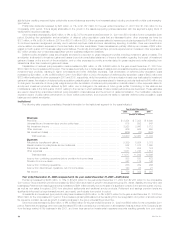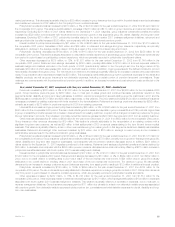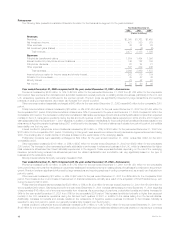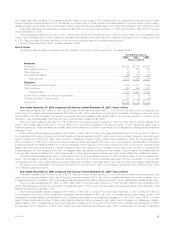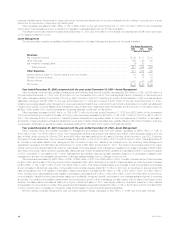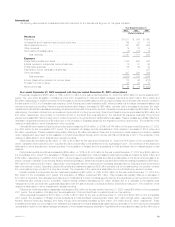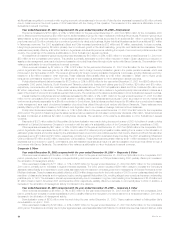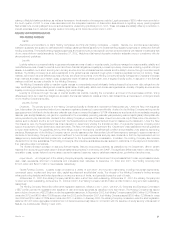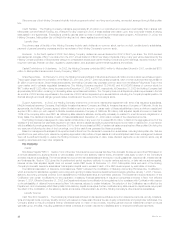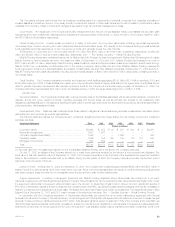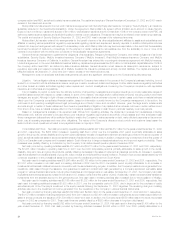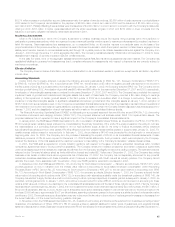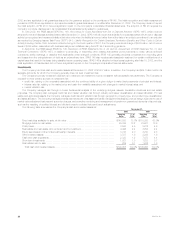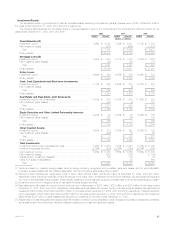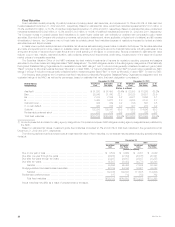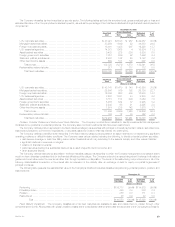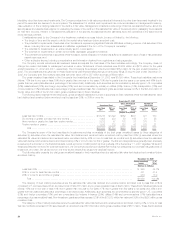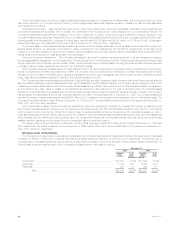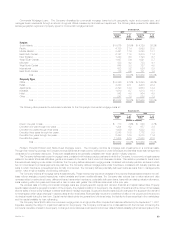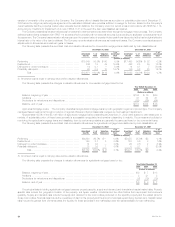MetLife 2002 Annual Report Download - page 28
Download and view the complete annual report
Please find page 28 of the 2002 MetLife annual report below. You can navigate through the pages in the report by either clicking on the pages listed below, or by using the keyword search tool below to find specific information within the annual report.company action level RBC, as defined by state insurance statutes. The capital and surplus of General American at December 31, 2002 and 2001 was in
excess of the referenced amounts.
Metropolitan Life has entered into a net worth maintenance agreement with Security Equity Life Insurance Company (‘‘Security Equity’’), an insurance
subsidiary acquired in the GenAmerica transaction. Under the agreement, Metropolitan Life agreed without limitation as to amount to cause Security
Equity to have a minimum capital and surplus of $10 million, total adjusted capital at a level not less than 150% of the company action level RBC, as
defined by state insurance statutes, and sufficient liquidity to meet its current obligations. The agreement may be terminated under certain circumstances.
The capital and surplus of Security Equity at December 31, 2002 and 2001 was in excess of the referenced amounts.
Metropolitan Life has also entered into arrangements for the benefit of some of its other subsidiaries and affiliates to assist such subsidiaries and
affiliates in meeting various jurisdictions’ regulatory requirements regarding capital and surplus and security deposits. In addition, Metropolitan Life has
entered into a support arrangement with respect to a subsidiary under which Metropolitan Life may become responsible, in the event that the subsidiary
becomes the subject of insolvency proceedings, for the payment of certain reinsurance recoverables due from the subsidiary to one or more of its
cedents in accordance with the terms and conditions of the applicable reinsurance agreements.
General American has agreed to guarantee the obligations of its subsidiary, Paragon Life Insurance Company, and certain obligations of its former
subsidiaries, Security Equity, MetLife Investors Insurance Company (‘‘MetLife Investors’’), First MetLife Investors Insurance Company and MetLife
Investors Insurance Company of California. In addition, General American has entered into a contingent reinsurance agreement with MetLife Investors.
Under this agreement, in the event that MetLife Investors’ statutory capital and surplus is less than $10 million or total adjusted capital falls below 150% of
the company action level RBC, as defined by state insurance statutes, General American would assume as assumption reinsurance, subject to
regulatory approvals and required consents, all of MetLife Investors’ life insurance policies and annuity contract liabilities. The capital and surplus of
MetLife Investors’ at December 31, 2002 and 2001 was in excess of the referenced amounts.
Management does not anticipate that these arrangements will place any significant demands upon the Company’s liquidity resources.
Litigation. Various litigation claims and assessments against the Company have arisen in the course of the Company’s business, including, but not
limited to, in connection with its activities as an insurer, employer, investor, investment advisor and taxpayer. Further, state insurance regulatory authorities
and other federal and state authorities regularly make inquiries and conduct investigations concerning the Company’s compliance with applicable
insurance and other laws and regulations.
It is not feasible to predict or determine the ultimate outcome of all pending investigations and legal proceedings or provide reasonable ranges of
potential losses except with respect to certain matters. In some of the matters, very large and/or indeterminate amounts, including punitive and treble
damages, are sought. Although in light of these considerations, it is possible that an adverse outcome in certain cases could have a material adverse
effect upon the Company’s consolidated financial position, based on information currently known by the Company’s management, in its opinion, the
outcomes of such pending investigations and legal proceedings are not likely to have such an effect. However, given the large and/or indeterminate
amounts sought in certain of these matters and the inherent unpredictability of litigation, it is possible that an adverse outcome in certain matters could,
from time to time, have a material adverse effect on the Company’s operating results or cash flows in particular quarterly or annual periods.
Based on management’s analysis of its expected cash inflows from operating activities, the dividends it receives from subsidiaries, including
Metropolitan Life, that are permitted to be paid without prior insurance regulatory approval and its portfolio of liquid assets and other anticipated cash
flows, management believes there will be sufficient liquidity to enable the Company to make payments on debt, make dividend payments on its common
stock, pay all operating expenses and meet other obligations. The nature of the Company’s diverse product portfolio and customer base lessen the
likelihood that normal operations will result in any significant strain on liquidity in 2003.
Consolidated cash flows. Net cash provided by operating activities was $4,997 million and $4,512 million for the years ended December 31, 2002
and 2001, respectively. The $485 million increase in operating cash flow in 2002 over the comparable 2001 period is primarily attributable to sales
growth in the group life, dental, disability and long-term care businesses, the sale of a significant retirement and savings contract in the second quarter of
2002, as well as additional sales of structured settlements and traditional annuity products. In addition, a large annuity contract sold in the first quarter of
2002 to a Canadian trust company and increased sales in South Korea due to larger professional sales force and improved agent productivity. These
increases were partially offset by a contribution by the Company to its defined benefit pension plans in December 2002.
Net cash provided by operating activities was $4,512 million and $3,277 million for the years ended December 31, 2001 and 2000, respectively.
The $1,235 million increase in operating cash flow in 2001 over the 2000 comparable period is primarily attributable to sales growth in the dental,
disability, long-term care and group life products, partially offset by decreases in the sales of retirement and savings products. An increase in operating
cash flows resulted from additional sales of group life, major medical and individual life products in Mexico. Protection-type product sales fostered by the
continued expansion of the professional sales force accounted for additional premiums from South Korea.
Net cash used in investing activities was $16,996 million and $3,165 million for the years ended December 31, 2002 and 2001, respectively. The
$13,831 million increase in net cash used in investing activities in 2002 over the 2001 comparable period is partly attributable to an increase in
investments held as cash collateral received in connection with the securities lending program. In addition, the Company invested income generated from
operations, cash raised through the issuance of a guaranteed investment contract and cash generated by a company-sponsored real estate sales
program in various financial instruments, including fixed maturities and mortgage loans on real estate. At December 31, 2001, the Company held cash
equivalents that were subsequently invested in bonds and U.S. treasury notes in the first quarter of 2002. Additionally, certain contractholders transferred
investments from the separate account to the general account. Net cash used in investing activities also increased due to the acquisition of Hidalgo.
Net cash used in investing activities was $3,165 million and $1,232 million for the years ended December 31, 2001 and 2000, respectively. Net
cash used in investing activities increased $1,933 million in 2001, over the comparable period in 2000, due in large part to the purchase of equity
securities as part of the Company’s investment in the equity markets following the September 11, 2001 tragedies. The remaining change in investing
activities was due to the investment of income generated from the operations of the Company in various financial instruments.
Net cash provided by financing activities was $6,849 million and $2,692 million for the years ended December 31, 2002 and 2001, respectively.
The $4,157 million increase in financing activities in 2002 from 2001 was due to a $2,401 million increase in policyholder account balances primarily from
sales of annuity products, the issuance of $1,536 million in short-term debt. In addition, the Company spent $850 million less in the stock repurchase
program in 2002 as compared to 2001. These cash flows are partially offset by a $592 million decrease in long-term debt issued.
Net cash provided by financing was $2,692 million for the year ended December 31, 2001. Net cash used in financing was $1,400 million for the
year ended December 31, 2000. Net cash provided by financing activities increased $4,092 million in 2001 from 2000, partially attributable to a
MetLife, Inc.
24


